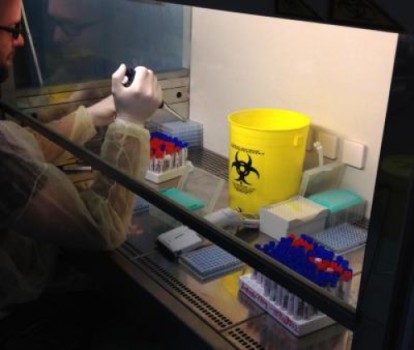
The MERS coronavirus has caused disease outbreaks across the Arabian Peninsula and spread to Europe several times. The severe pneumonia virus has claimed the lives of several hundred people since its discovery in 2012. For a long time, scientists have been puzzled over how easily the pathogen spreads from human to human. An international team of researchers led by virologists from the University of Bonn have now come to the conclusion, through direct observation, that the rate of human transmission is low. Still, a third of infected persons with symptoms die. The results are now being presented in the New England Journal of Medicine.
The “Middle East Respiratory Syndrome Coronavirus” (MERS-CoV) was detected for the first time in 2012 on the Arabian Peninsula from where it spread to Europe and the USA, among other places. The virus causes severe acute lung infection. A total of at least 856 cases of illness have been registered in the meantime and at least 241 people have died. Scientists are puzzling over how infectious the disease is and how high the estimated number of unrecognized cases is. To date, there have been only theoretical projections.
For the first time, an international team of scientists led by Professor Christian Drosten at the Institute of Virology has been able to directly determine the rate of infection. “The transmissibility of the virus and the estimated number of unknown cases are low,” says Prof. Drosten, summarizing the results. In Saudi Arabia, after new infections occurred, the researchers tracked how the disease spread further in the patients’ home environments. A total of 280 people who lived in the households of 26 infected persons were examined. There was an infection in not more than twelve cases (four percent). “Since each infected person infected significantly fewer than one additional person, it can be assumed that the MERS virus will not cause a pandemic,” concludes the virologist. A disease spreads rapidly only if each infected person infects several other people.
Along with people, dromedaries are an additional source of infection
However, the scientists say there is no reason for complacency: “Even if the rate of transmission is low: The MERS infection is very dangerous and about one-third of symptomatic patients die from the infection,” says Prof. Drosten. Along with person-to-person infection, there is another important source: As a team of researchers working with Prof. Drosten published a year ago, dromedaries may be involved in transmission of the virus. They are widespread in the Middle East and could be responsible for a portion of human illnesses due to their close contact with people.
In the virologist’s opinion, the fact that MERS infection rates significantly increase in the spring supports this hypothesis. At this time, there are many newborn camels and the one-year-old animals are separated from mothers which respectively causes an increased risk of infection. “Preventing an infection passed from animal to animal and then to people is not easy,” says Prof. Drosten. One option would be to develop a MERS vaccine for camels. However, in the vast region of the Arab Peninsula vaccination coverage is logistically difficult to implement.
Virologists from the University of Bonn Hospital develop a new test
The virologists from the University of Bonn Hospital have for the first time developed a reliable method for detecting MERS infections in Saudi Arabian households. This method is used for the serological detection of antibodies in the blood. The new test is to be marketed soon by a German company and it will then be available to all physicians. Access to the families of infected persons in the Arabic country was a significant challenge for the international team of researchers from Germany, Saudi Arabia, the Netherlands and England. Dr. Ziad Memish, who was then the deputy Minister of Health in Saudi Arabia and senior author of the publication, helped convince people to be examined for the study.
Story Source:
The above story is based on materials provided by Universität Bonn. Note: Materials may be edited for content and length.
Journal Reference:
- Christian Drosten, Benjamin Meyer, Marcel A. Müller, Victor M. Corman, Malak Al-Masri, Raheela Hossain, Hosam Madani, Andrea Sieberg, Berend Jan Bosch, Erik Lattwein, Raafat F. Alhakeem, Abdullah M. Assiri, Waleed Hajomar, Ali M. Albarrak, Jaffar A. Al-Tawfiq, Alimuddin I. Zumla, Ziad A. Memish. Transmission of MERS-Coronavirus in Household Contacts. New England Journal of Medicine, 2014; 371 (9): 828 DOI: 10.1056/NEJMoa1405858
